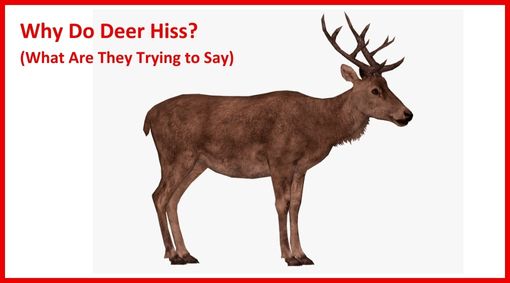Deer can communicate through various sounds, including hiss, bleats, snorts, grunts, stomping, and flagging.
Bleats are higher-pitched sounds made by does to communicate with other deer, particularly fawns. Snorts, resembling a forceful exhale, serve as alarm signals.
Bucks produce loud grunts to assert their dominance, while stomping hooves can warn other deer or deter threats.
Additionally, deer communicate visually through tail flagging, raising their tails to reveal the bright white underside as a warning.
On the other hand, deer hissing is a snort-like sound made by blowing air through their nostrils, indicating alarm or agitation and serving as a warning to other deer. It is crucial for hunters and observers to recognize deer hissing as a sign of heightened alertness.
What Is Deer Hiss?
Deer hissing is a sound made by deer by blowing air through their nostrils. It is often described as a snort or wheeze-like sound.
Deer hissing is typically a sign of alarm or agitation, and it can be a warning to other deer in the area. When a deer hisses, it may be indicating that it senses potential danger or feels threatened.
It is important for hunters and observers to be aware of deer hissing as it can be a signal that the deer is on high alert.
Why Do Deer Hiss?
While deer are not typically known to hiss, there are a few instances where they may make a hissing sound. It is important to note that hissing is not a common vocalization for deer and is not a primary mode of communication for them.
Warning Off Predators or Threats:
One possible reason why a deer may hiss is to warn off predators or other animals that are in their vicinity. The hissing sound can be quite intimidating and may be used as a defensive mechanism to discourage potential threats from approaching.
Vocalization Variation:
Deer can produce a range of vocalizations, and some individuals may exhibit unique behaviors and sounds that are not commonly observed in the species as a whole. It is possible that a particular deer may make a hissing sound due to individual variation or learned behavior.
Misinterpretation:
It is also worth mentioning that sometimes people may misinterpret certain sounds made by deer as hissing. For example, when deer are alarmed or feel threatened, they may exhibit alert behaviors such as snorting or blowing air forcefully through their nostrils. These sounds can be mistaken for hissing, but they serve a different purpose in communication.
What Sound Deer Makes
Deer can produce a variety of sounds to communicate with each other. Some of the sounds that deer make include:
Doe Grunt
A doe grunt is a vocalization made by female deer, specifically does. It is a higher-pitched sound compared to the grunts produced by bucks.
Doe grunts are commonly used by female deer to communicate with other deer, particularly fawns. The purpose of the doe grunt can vary. It can be used to signal relaxation and calmness among other deer in the vicinity.
Additionally, during the breeding season, a doe grunt can be made as a sign of readiness for mating. It may also be used to attract the attention of a buck or to indicate resistance if the doe is playing hard to get.
The doe grunt is an important aspect of deer communication and plays a role in their social interactions.
Deer Snorts:
When deer snort, they make a distinct sound that can vary in pitch and intensity. Snorting is often associated with alarm or danger, as it serves as an alarm signal to other deer in the area.
The sound of a deer snort can be described as a forceful exhale or a sharp whistle. When deer hear this snort, they may immediately sprint for cover without pausing to investigate the source of potential danger. However, it’s important to note that deer snorts don’t always indicate danger.
In some cases, snorting can be a form of curiosity communication or a response to unfamiliar stimuli. The context and behavior of the deer should be considered when interpreting snorts.
Bucks Grunt:
A buck grunt is a vocalization made by male deer, specifically bucks. It is a deep, guttural sound that bucks produce to communicate with other deer, especially during the rut (breeding season).
Bucks use grunts to establish dominance, attract mates, and communicate with other bucks in their territory. The grunt of a buck can vary in intensity and pitch, depending on the situation and the buck’s intentions.
Bucks may emit short, aggressive grunts when asserting dominance or longer, deeper grunts when courting a doe. Grunting is a common form of communication among bucks and plays a crucial role in their social interactions during the breeding season.
Deer Stomping:
Deer stomping refers to the behavior of deer forcefully striking the ground with their hooves.
This behavior can be observed in both bucks and does and serves as a form of non-verbal communication. Deer may stomp their feet in response to various stimuli or situations.
- Alarm or Alert: Deer stomping is often associated with alarm or alertness. When deer sense potential danger or perceive a threat in their surroundings, they may stomp their feet to alert other deer in the area. The loud sound created by the stomping can signal danger and prompt other deer to be cautious or flee.
- Warning or Aggression: Stomping can also be a warning or aggressive behavior displayed by deer. In some instances, deer may stomp their feet to assert dominance or warn other deer to back off. This behavior is more commonly observed in mature bucks during the rut when they are competing for mates or establishing dominance.
- Communication: Stomping can also serve as a means of communication between deer. It can convey important information about the presence of predators, potential threats, or territorial boundaries. Other deer in the vicinity can interpret the stomping behavior and respond accordingly.
It’s important to note that deer stomping is just one component of their body language and should be considered alongside other behaviors and environmental cues to accurately interpret their intentions and emotions.
Deer Flagging:
Deer flagging refers to the behavior of white-tailed deer where they rapidly raise and lower their tails, often exposing the white underside. This behavior is commonly observed when deer are alarmed or perceive a potential threat in their surroundings.
There are several hypotheses that have been proposed to explain the function of deer flagging:
- Alarm Signal Hypothesis: According to this hypothesis, flagging is a visual signal to alert other deer of potential danger. The sudden movement of the raised tail and the flash of white can quickly draw the attention of nearby deer, signaling them to be on high alert and potentially flee from the area.
- Flash Behavior Hypothesis: This hypothesis suggests that flagging serves as a visual distraction or startle response to confuse predators. By rapidly raising and lowering their tails, deer create a sudden movement and change in their appearance, which may momentarily startle or confuse predators, buying the deer time to escape.
- Communication and Warning Hypothesis: Flagging may also serve as a form of communication between deer. It can signal danger or act as a warning to other deer in the vicinity. By flagging, a deer may be indicating to others that there is a potential threat nearby, prompting them to be cautious or flee.
It’s important to note that the exact function and purpose of flagging behavior in deer are still not fully understood and may vary depending on the specific context and individual deer.

What To Do When Deer Make Sounds?
When deer make sounds, it can indicate different things depending on the context. Here are a few actions you can consider taking when you hear deer making sounds:
Stay quiet and still:
If you’re in close proximity to deer and they start making sounds, it’s important to remain calm, quiet, and still. Sudden movements or loud noises can startle them and cause them to flee.
Observe their behavior:
Pay attention to the specific sounds the deer are making and their accompanying body language. This can give you clues about their level of alertness, the presence of danger, or their social interactions.
Assess the situation:
If the deer’s sounds and behavior indicate that they are alarmed or nervous, it’s possible that they have detected your presence or another potential threat. Assess your surroundings and see if there’s anything that may have caused their reaction.
Give them space:
If you suspect that the deer are aware of your presence and are on high alert, it’s best to give them space and avoid approaching them. This allows them to feel safe and reduces the likelihood of them fleeing or becoming aggressive.
Avoid eye contact:
Direct eye contact can be perceived as a threat by deer. If you’re in close proximity to them, avoid making direct eye contact and try to position yourself so that you’re not directly facing them.
Proceed with caution:
If you’re hunting or observing deer and want to get closer for a better view or shot, it’s important to move slowly and quietly. Use the surrounding cover to your advantage and make sure to keep a safe distance to avoid spooking the deer.
It’s important to note that deer are wild animals, and their behavior can be unpredictable. It’s always best to maintain a respectful distance and observe them from afar to avoid causing any unnecessary stress or harm to the animals.










